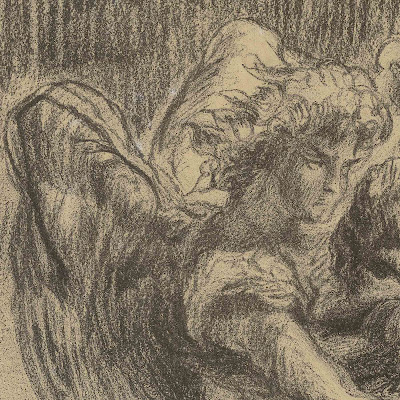“Jacob Wrestling with the Angel,” 1864,
published in Paris by Dusacq & Cie (fl.c1864–1869) after Eugène Delacroix’s (aka Ferdinand
Victor Eugène Delacroix) (1798–1863) 1850 chalk on tracing paper study (see https://www.themorgan.org/drawings/item/109711) for Delacroix’s oil and wax on
plaster, “Jacob Wrestling with the Angel,” completed in 1861, in the Saints-Anges' chapel of the Church of Saint-Sulpice, Paris.
Lithograph (possibly a transfer lithograph [autographie]) printed
in black ink on ochre coloured chine collé (China) paper laid onto a support sheet
after the removal from the original (but damaged) backing sheet. Note that Alfred
Robaut encouraged artists such as Delacroix and Corot to use the transfer process
of lithography, as this technique gave artists the freedom to draw on paper that
could later be transferred to lithographic stones, rather than the artists
having to work directly on problematically heavy limestone plates.
Size: (irregular sheet) 55.8 x 37.9 cm.
The Rijksmuseum offers a description of this print:
Ashley Dunn, Assistant Curator in the Department
of Drawings and Prints at the Met offers the following description of the Delacroix’s
design underpinning this lithograph:
“In Delacroix's design, Jacob and the angel appear
in the shallow foreground locked in combat at lower left. A grove of tall trees
rises dramatically behind them; the thick, overlapping trunks echo their
intertwined bodies. Through a clearing on the lower right, a cluster of figures
suggests the flock of sheep and caravan that Jacob accompanied before his
encounter with the angel”
For those unfamiliar with the subject portrayed in
this lithograph, the following account of Genesis (32:22–28) may be helpful:
“That night Jacob got up and took his two wives,
his two female servants and his eleven sons and crossed the ford of the Jabbok.
After he had sent them across the stream, he sent over all his possessions. So
Jacob was left alone, and a man wrestled with him till daybreak. When the
man saw that he could not overpower him, he touched the socket of Jacob’s hip
so that his hip was wrenched as he wrestled with the man. Then the man said,
“Let me go, for it is daybreak.” But Jacob replied, “I will not let you go
unless you bless me.” The man asked him, “What is your name?” “Jacob,” he
answered. Then the man said, “Your name will no longer be Jacob, but Israel, because
you have struggled with God and with humans and have overcome.”
Condition: very good impression but with many
small restorations (e.g. there is watercolour infilling along a break in the centrefold
and other hairline fractures) and the whole tissue-thin sheet has been removed
from its damaged original support sheet and is relined with a support of
archival (millennium quality) washi paper.
I am selling this graphically impressive and very
large lithograph of Delacroix’s chalk study of one of his most famous
compositions, for AU$292 in total (currently US$1208.63/EUR177.17/GBP159.46 at
the time of posting this print) including postage and handling to anywhere in
the world (but not, of course, any import duties/taxes imposed by some
countries).
If you are interested in purchasing this rare
lithograph—so rare that I have found only a single copy of it in any of the
major museum repositories (viz. the Rijksmuseum)!—please contact me
(oz_jim@printsandprinciples.com) and I will send you a PayPal invoice to make
the payment easy.
This print has been sold











No comments:
Post a Comment
Please let me know your thoughts, advice about inaccuracies (including typos) and additional information that you would like to add to any post.